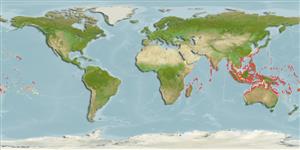>
Eupercaria/misc (Various families in series Eupercaria) >
Labridae (Wrasses) > Cheilininae
Etymology: Cheilinus: Greek, cheilos = lip (Ref. 45335).
More on author: Bloch.
Environment: milieu / climate zone / depth range / distribution range
Écologie
marin récifal; profondeur 1 - 30 m (Ref. 9823). Tropical; 32°N - 36°S, 25°E - 132°W
Indo-Pacific: East Africa to the Marquesan and Tuamoto islands, north to the Ryukyu Islands, south to New Caledonia and Rapa.
Taille / Poids / Âge
Maturity: Lm ? range ? - ? cm
Max length : 45.0 cm TL mâle / non sexé; (Ref. 9710)
Épines dorsales (Total) : 10; Rayons mous dorsaux (Total) : 8 - 9; Épines anales: 3; Rayons mous anaux: 8. The only Cheilinus that has 10 dorsal spines. Exhibits a coloration very similar to C. trilobatus, but has black and white specks on its pelvic, anal and caudal fins, while C. trilobatus has vertical red, white and black streaks on its body scales. Large adults of both species have numerous red spots and streaks on the head and trilobed caudal fins.
Adults inhabit lagoon and coastal reefs, in areas with mixed sand, rubble, and coral (Ref. 9710). Occasionally in grassy areas. Feed mainly on benthic invertebrates such as mollusks and crustaceans. Oviparous, distinct pairing during breeding (Ref. 205).
Life cycle and mating behavior
Maturities | Reproduction | Spawnings | Egg(s) | Fecundities | Larves
Oviparous, distinct pairing during breeding (Ref. 205).
Westneat, M.W., 2001. Labridae. Wrasses, hogfishes, razorfishes, corises, tuskfishes. p. 3381-3467. In K.E. Carpenter and V. Niem (eds.) FAO species identification guide for fishery purposes. The living marine resources of the Western Central Pacific. Vol. 6. Bony fishes part 4 (Labridae to Latimeriidae), estuarine crocodiles. FAO, Rome. (Ref. 9823)
Statut dans la liste rouge de l'IUCN (Ref. 130435)
Menace pour l'homme
Harmless
Utilisations par l'homme
Pêcheries: intérêt commercial mineur; Aquarium: Commercial
Outils
Articles particuliers
Télécharger en XML
Sources Internet
Estimates based on models
Preferred temperature (Ref.
123201): 25 - 29.3, mean 28.5 °C (based on 3199 cells).
Phylogenetic diversity index (Ref.
82804): PD
50 = 0.5078 [Uniqueness, from 0.5 = low to 2.0 = high].
Bayesian length-weight: a=0.01820 (0.01159 - 0.02858), b=2.94 (2.81 - 3.07), in cm total length, based on LWR estimates for this species & (Sub)family-body (Ref.
93245).
Niveau trophique (Ref.
69278): 3.5 ±0.52 se; based on food items.
Résilience (Ref.
120179): Milieu, temps minimum de doublement de population : 1,4 à 4,4 années (Preliminary K or Fecundity.).
Fishing Vulnerability (Ref.
59153): Low to moderate vulnerability (35 of 100).
Nutrients (Ref.
124155): Calcium = 37.9 [21.2, 83.6] mg/100g; Iron = 0.614 [0.269, 1.382] mg/100g; Protein = 17.8 [13.6, 21.1] %; Omega3 = 0.0958 [, ] g/100g; Selenium = 32 [16, 69] μg/100g; VitaminA = 205 [38, 915] μg/100g; Zinc = 2.71 [1.53, 4.34] mg/100g (wet weight);
